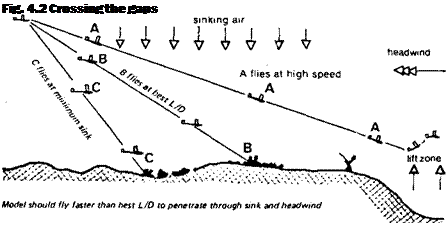GLIDERS: PENETRATING
Gliders hardly ever need to fly at the speed which yields the best L/D ratio or flattest glide •in still air. As a rule, they are either soaring or penetrating. When penetrating, a speed • faster than that for L/D max is needed. For example, in making headway against a wind, if the model’s best L/D airspeed is 10 metres/sec., and it faces a wind of slightly more than that speed, flight at best L/D will cause it to move backwards relative to the ground. A higher speed would enable some forward progress to be achieved, albeit at a high rate of. descent In addition, between upcurrent zones, thermal or hill lift, there is almost always sinking air. A detailed analysis of the behaviour of sailplanes in such conditions is to be found in most books about foil-sized gliding, but the modeller does not have the benefit of ^Instruments and computers in the cockpit to tell him what his best speed to fly should be.

5 As a very rough approximation, the model might achieve best results on many occasions
by flying between lift areas at about twice its stalling speed, and faster still if it needs to make ground against the wind (Fig. 4.2). This requires efficient, low drag aerodynamic design over a wide range of lift coefficients, from, perhaps, Cl 1 0 down to Cl 0.2 or 0.3. While the best L/D ratio remains a useful indication of a model’s all-round efficiency, it is rarely important in practice.











